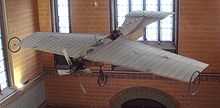Robert Esnault-Pelterie
| Robert Esnault-Pelterie | |
|---|---|
 Robert Esnault-Pelterie | |
| Born |
November 8, 1881 Paris, France |
| Died |
December 6, 1957 (aged 76) Geneva, Switzerland [1] |
| Nationality | French |
| Engineering career | |
| Significant advance | |
Biography
He was born on November 8, 1881 in Paris to a textile industrialist. He was educated at the Faculté des Sciences, studying engineering at the Sorbonne.
He served in World War I and was made an Officier de la Légion d'Honneur.
In November, 1928, on board the Ile de France while sailing to New York, he was married to Carmen Bernaldo de Quirós, the daughter of Don Antonio and Yvonne Cabarrus, and granddaughter of General Marquis of Santiago, Grandee of Spain, Head of the Military Household of Queen Isabella II.
He died on December 6, 1957 in Geneva.
Flight experiments
His first experiments in aviation were based on the Wright brothers 1902 glider. His first glider design was tested on a beach near Calais, but was not successful. His glider was based upon an incomplete understanding of the Wright glider, and although using a version of the wing-warping which the Wright brothers had used to control their aircraft this did not work properly and was abandoned, since he considered it dangerous.[2] After condemning the Wright brothers' approach, he developed the concept of the aileron along the trailing edge. This is now a standard roll maneuvering element on most modern aircraft. (Note that the aileron was also invented independently by the Aerial Experiment Association, headed by Alexander Graham Bell).

In 1906 he began his first experiments in towed flight. On 19 September 1906 he flew 500 m (1,600 ft). He made his first powered flight on October 10, 1907, a distance of 100 m (330 ft) with the Pelterie I (or R.E.P. I). This was driven by a seven cylinder, 30 hp air-cooled engine of his own design.

Trials of the monoplane Pelterie II began on June 8, 1908. This aircraft set a record with a 1,200 m (3,900 ft) flight, reaching an altitude of 30 m (98 ft). After a modified version of this plane was flown for the last time in 1909 at Rheims, Pelterie stopped flying and instead focused on the development and manufacture of aircraft.
The Vickers R.E.P. Type Monoplane was based upon his designs, and marked the beginning of aircraft production at the later Vickers Limited.

His family had invested heavily to fund his aircraft designs, and this had left them nearly financially ruined. However, he was the inventor of the "joystick" flight control, and owned a patent on the design. Following the war he was involved in litigation over his joystick patent.[3] Many aircraft built during the war had used this design and the aircraft companies owed him royalties. The damages he won and subsequent royalties made him a wealthy man. This also allowed him to repay his father's significant investment.
Rocketry
He became interested in space travel, and, not knowing of Tsiolkovsky's 1903 work, in 1913 produced a paper that presented the rocket equation and calculated the energies required to reach the Moon and nearby planets.[4] In this talk, he proposed the use of atomic energy, using 400 kg of radium to power an interplanetary vehicle. His culminating work was L'Astronautique, published in 1930. A later version published in 1934 included details on interplanetary travel and applications of nuclear power.
On June 8, 1927, Robert gave a symposium for the French Astronautics Society titled L'exploration par fusées de la très haute atmosphère et la possibilité des voyages interplanétaires, concerning the exploration of outer space using rocket propulsion. Jean-Jacques Barre attended this lecture, and developed a correspondence with Esnault-Pelterie on the topic of rockets.
In 1929 Robert proposed the idea of the ballistic missile for military bombardment. By 1930, Robert and Jean-Jacques had persuaded the French War Department to fund a study of the concept. In 1931, the two began experimenting with various types of rocket propulsion systems, including liquid propellants. The same year he ran a demonstration of a rocket engine powered with gasoline and liquid oxygen. During an experiment with a rocket design using tetra-nitromethane he lost three fingers from his right hand during an explosion. Unfortunately their work failed to galvanize an interest in rocketry within France.
Legacy
Among his interests were horseback riding, playing golf, camping and driving cars. During his lifetime he filed about 120 patents in a variety of fields ranging from metallurgy to automobile suspension. He was the inventor of the "joystick" aircraft control, radial engines, and of a new type of fuel pump. He also developed the idea of rocket maneuver by means of vectored thrust.
Works by Esnault-Pelterie
- L'Astronautique, Paris, A. Lahure, 1930.
- L'Astronautique-Complément, Paris, Société des Ingénieurs Civils de France,1935.
Honors
- Member of the French Academy.
- The crater Esnault-Pelterie on the Moon is named after him.
See also
References
- ↑ "International Space Hall of Fame :: New Mexico Museum of Space History :: Inductee Profile". Retrieved 4 December 2011.
- ↑ Gibbs-Smith 1974 p.128
- ↑ "The French “Manche A Balai” Action". Flight 15 (753): 297. 31 May 1923. Retrieved 25 Aug 2013.
- ↑ "Considerations sur les resultats d'un allegement indefini des moteurs", Journal de physique theorique et appliquee, Paris, 1913
Bibliography
- Gibbs-Smith, C.H. The Rebirth of European Aviation. London, HMSO, 1974 ISBN 0-11-290180-8
External links
| |||||
|